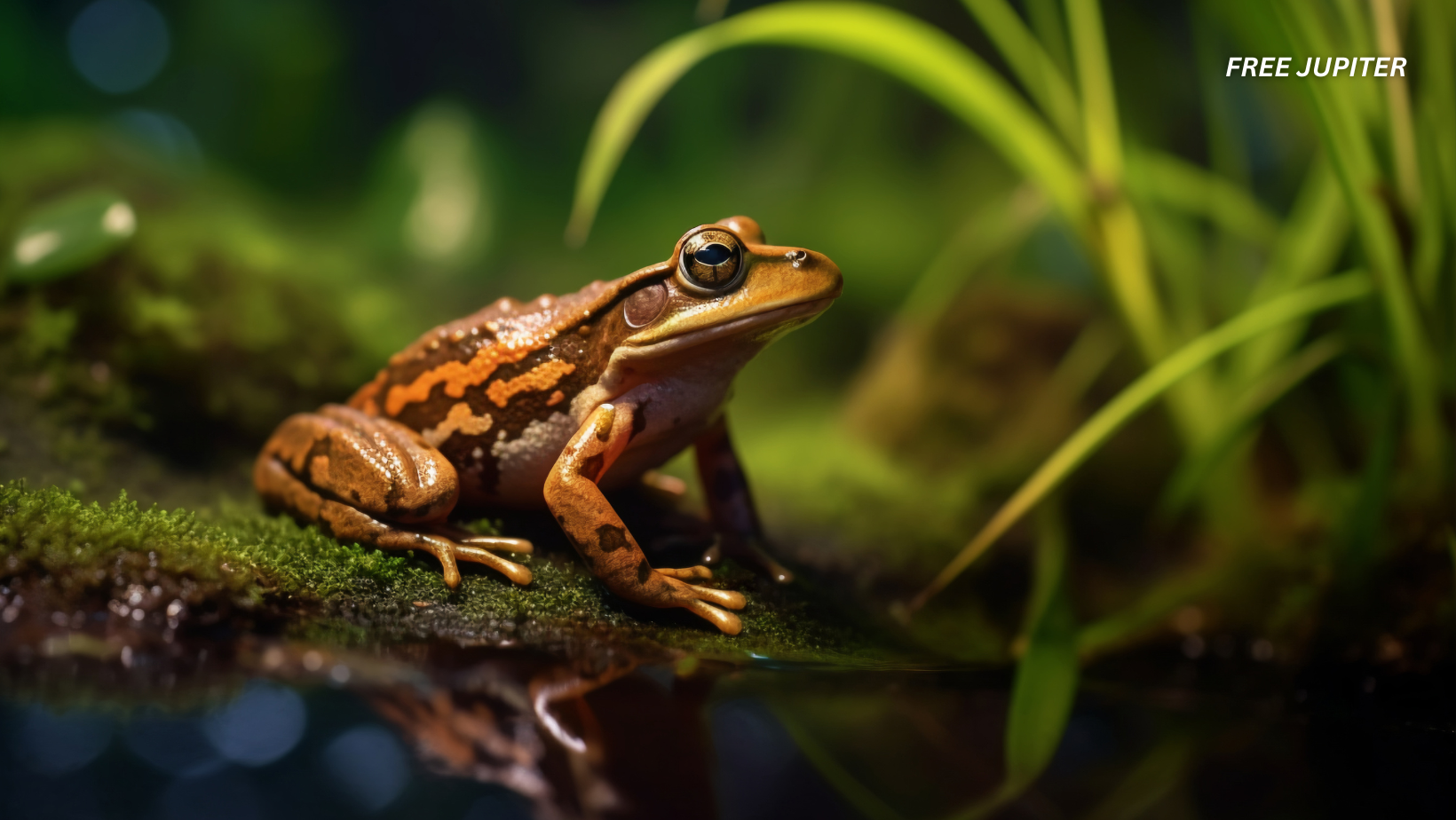Friendly Note: FreeJupiter.com shares general info for curious minds 🌟 Please fact-check all claims—and always check health matters with a professional 💙
When it comes to dating, some animals have to get…creative. For female frogs, the chaos of mating season can be overwhelming, even dangerous. So, in what might be the most theatrical rejection technique in the animal kingdom, some of them have evolved a jaw-dropping strategy:
Yes, some female frogs literally go limp, stiffen up, and play dead to escape persistent males. And as strange as it sounds, this isn’t just amphibian drama—it’s a survival tactic grounded in evolutionary biology. Even more fascinating? Frogs aren’t the only ones doing it.
Let’s dive into the frog tale first—then explore the other weird, wonderful creatures that share this strange, yet effective, way of saying “no thanks.”
The Original Study: A Frog’s Last Resort
The behavior was observed in the European common frog (Rana temporaria) during the breeding season, when ponds become packed with males all searching for a mate. The numbers are skewed—males often outnumber females by a large margin—creating an intense scramble.
This often leads to what researchers call “explosive breeding,” where multiple males pile onto one female in a frenzied attempt to reproduce. These dogpiles are not just uncomfortable—they can be life-threatening, sometimes causing the female to drown.
To escape these high-pressure encounters, female frogs have been seen:
- Twisting and kicking their legs
- Emitting high-pitched distress calls
- And now—entering tonic immobility, also known as playing dead
In this state, the female becomes completely still and rigid, mimicking a lifeless body. Males, confused or uninterested in an unresponsive mate, often let go and search elsewhere. Scientists believe this is the first recorded instance of a frog using death-feigning to avoid mating.
Read more: Chernobyl’s Radioactive Zone Is Creating a New Kind of Dog
Related Stories: When “Playing Dead” Is the Smartest Move
Interestingly, frogs aren’t the only creatures turning to this dramatic survival trick. Across the animal kingdom, researchers have found similar behaviors in insects, reptiles, mammals, and even birds—all using tonic immobility as a last resort to avoid threats. Here are a few standout examples:
🐉 Dragonflies Faking Death to Ditch Males
In 2017, biologist Rassim Khelifa observed a fascinating behavior in female moorland hawker dragonflies in the Swiss Alps. When chased by aggressive males, the females would:
- Suddenly drop from the sky
- Crash into the grass
- Lie completely motionless, wings outstretched
To any observer—including the pursuing males—they appeared dead. But once the coast was clear, the females would spring back to life and fly off.
Khelifa noted this as the first evidence of death-feigning in odonates (the group that includes dragonflies and damselflies) as a mating avoidance tactic. Like the frogs, these dragonflies used stillness as a decoy—a brilliant way to escape unwanted advances in mid-air.
🐜 Beetles That Play Dead to Avoid Mating—and Predators
Among red flour beetles, males and females both use tonic immobility—but for different reasons.
- Males sometimes feign death when approached by larger, more dominant rivals during mating.
- Females, meanwhile, go limp when cornered by overly persistent suitors or potential predators.
Interestingly, researchers found that beetles who were better at faking death actually had higher survival rates—especially females. It’s a small-scale version of what’s happening in the frog world, with death-feigning serving a dual purpose: escape and self-preservation.
🐍 Snakes That Take It a Step Further
The Eastern hognose snake might be the animal kingdom’s most committed actor. When threatened, it puts on a full-blown performance:
- Hisses loudly
- Flattens its head like a cobra
- If that doesn’t work, rolls over
- Opens its mouth
- Lets its tongue hang out
And finally—just to seal the deal—it emits a foul-smelling musk, playing dead so convincingly that it even fools experienced predators.
Though it’s typically a predator-avoidance strategy, this snake’s dedication shows just how effective tonic immobility can be when there are no better options.
Read more: No Touchscreen. No Paint. No Stereo. Just a $20K American-Made Electric Truck That Works
🕷️ Spiders Using Mating Freeze as a Strategy
In some nursery web spiders, males offer a “nuptial gift”—usually a fly wrapped in silk—to distract the female during mating. But here’s the twist: if the female starts getting aggressive, the male may go limp mid-mating.
This freeze can stop the female from attacking or cannibalizing him. In some cases, the female even continues copulating with the “dead” male, allowing him to reproduce safely without ending up as dinner. It’s a literal “play dead or die” situation.
🐦 Birds and Death Feigning for Survival
Certain bird species, such as quail and some types of plovers, also show tonic immobility, especially when caught by predators. Although this isn’t a mating-specific behavior, it demonstrates how this freeze response is hardwired across many species as an instinctive act of desperation.
Interestingly, the more stressful the encounter, the longer the bird stays immobile—much like the frog’s reflex under overwhelming pressure.
Why These Behaviors Matter
While all of these creatures are vastly different, they share a common thread: they’ve evolved a biological shutdown mechanism for when everything else fails. Whether it’s a dragonfly dropping from the sky or a frog stiffening mid-pileup, these behaviors reflect just how versatile and adaptive survival can be.
From an evolutionary lens, tonic immobility represents a “last card to play”—a moment where the body says, “If nothing else works, pretend it’s all over and hope for the best.”
And in many cases, it works surprisingly well.
What Scientists Are Asking Next
The frog study—and all these other examples—have opened the door to new questions in animal behavior and evolutionary biology:
- Are these responses more widespread than we think?
- Do they vary depending on population density or environmental stress?
- Can tonic immobility be triggered by social pressure alone, rather than predatory fear?
- And what does this tell us about the inner lives of animals—their thresholds, instincts, and even agency?
As researchers continue to explore the emotional and behavioral complexity of animals, tactics like death-feigning challenge the idea that creatures operate on pure instinct. There’s strategy involved—however unconscious—and that suggests a world far more dynamic than we often give credit for.
Read more: Cat Behaviorists Explain Why Your Feline Won’t Leave You Alone in the Bathroom
Final Thoughts: Drama, Defense, and the Strangely Relatable Frog
The image of a frog flopping limp in a pond to avoid a clingy suitor might seem funny at first. But behind the humor lies a serious evolutionary story—a story of survival, boundaries, and the weird, wild ways life finds to adapt.
And in an odd way, it’s deeply relatable.
When the pressure’s too much, and all options are exhausted, sometimes the smartest thing you can do is pause. Go still. Wait it out. Even in the animal kingdom, sometimes doing nothing is the boldest move of all.










